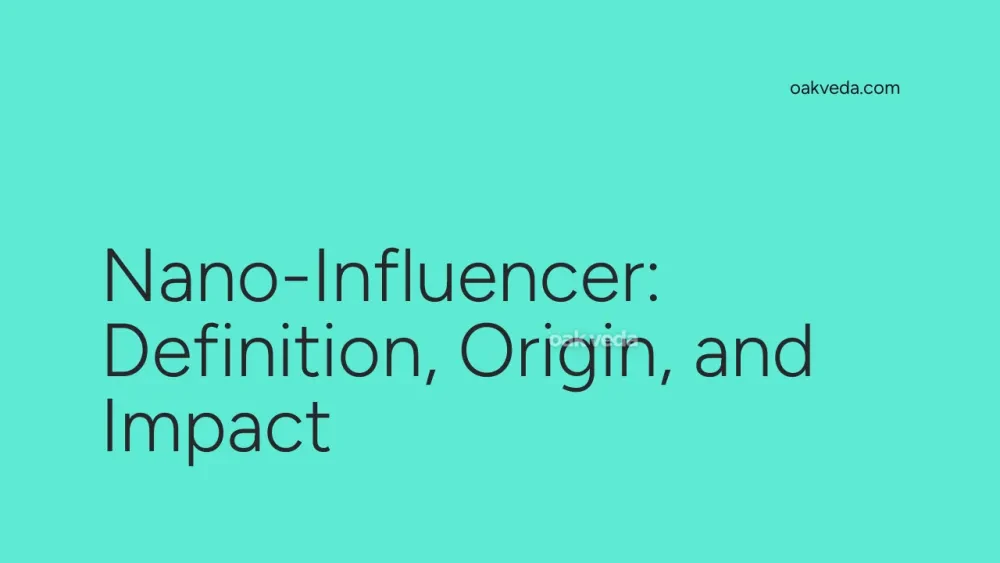
What is a Nano-Influencer?
A nano-influencer is a social media user with a relatively small but highly engaged following, typically ranging from 1,000 to 10,000 followers. These individuals have built a niche audience around specific interests, lifestyles, or expertise. Unlike macro-influencers or celebrities, nano-influencers are often perceived as more relatable and authentic, making their recommendations highly trusted by their followers.
Origin and Development of Nano-Influencers
The concept of nano-influencers emerged as a natural evolution of influencer marketing. As social media platforms matured and algorithms changed to prioritize engagement over follower count, brands began to recognize the value of smaller, more focused audiences. The term "nano-influencer" gained traction around 2018, reflecting a shift towards more authentic and targeted marketing strategies.
How Nano-Influencers Work
Nano-influencers operate by creating content that resonates with their small but dedicated audience. They often specialize in niche topics, from sustainable living to local food scenes. Their power lies in their ability to foster genuine connections with followers, leading to higher engagement rates compared to influencers with larger followings.
Key characteristics of nano-influencers include:
- High engagement rates (likes, comments, shares)
- Strong personal connections with followers
- Niche expertise or lifestyle focus
- Authenticity and relatability
- Cost-effectiveness for brands
Types of Nano-Influencers
While nano-influencers are defined by their follower count, they can be further categorized based on their content focus:
- Lifestyle nano-influencers: Share daily life, fashion, and personal experiences
- Niche experts: Focus on specific topics like tech reviews or vegan cooking
- Local nano-influencers: Concentrate on community-specific content
- Micro-micro influencers: Those with even smaller followings (500-1,000)
Popular Examples of Nano-Influencers
While nano-influencers are, by definition, not widely known, some have gained recognition within their niches. For example:
- @zerowastechef on Instagram (sustainable living)
- @blackgirlswhoblog on Twitter (blogging and diversity)
- @thetinytravellerr on TikTok (budget travel tips)
These accounts demonstrate the power of focused content and community engagement.
Impact of Nano-Influencers on Social Media Culture
Nano-influencers have significantly impacted social media culture by:
- Democratizing influence: Anyone with passion and expertise can become an influencer
- Emphasizing authenticity: Shifting focus from polished content to genuine experiences
- Localizing content: Providing platforms for community-specific information and recommendations
- Diversifying voices: Amplifying perspectives from various backgrounds and niches
Controversies Surrounding Nano-Influencers
While generally viewed positively, nano-influencers face some challenges:
- Disclosure concerns: Ensuring proper disclosure of sponsored content
- Maintaining authenticity: Balancing genuine recommendations with brand partnerships
- Scalability issues: Brands managing multiple nano-influencer relationships simultaneously
How Brands and Influencers Use Nano-Influencers
Brands are increasingly incorporating nano-influencers into their marketing strategies:
- Product seeding: Sending free products for organic mentions
- Affiliate marketing: Providing unique discount codes or links
- Local promotions: Partnering for community-specific campaigns
- User-generated content: Encouraging nano-influencers to create branded content
Nano-influencers benefit from these partnerships through:
- Free products or experiences
- Monetary compensation (though often less than larger influencers)
- Increased visibility and follower growth
- Opportunities for long-term brand ambassadorships
Future Trends Related to Nano-Influencers
The nano-influencer trend is likely to continue growing, with several emerging trends:
- AI-powered matching: Advanced algorithms to connect brands with suitable nano-influencers
- Micro-communities: Platforms facilitating connections between nano-influencers and their audiences
- Nano-influencer collectives: Groups of nano-influencers collaborating for increased reach
- Hyper-local focus: Emphasis on extremely localized content and partnerships
FAQs about Nano-Influencers
Q: How many followers does a nano-influencer typically have? A: Nano-influencers generally have between 1,000 and 10,000 followers.
Q: Are nano-influencers more effective than macro-influencers? A: They can be more effective for niche markets or local promotions due to higher engagement rates and perceived authenticity.
Q: How much do nano-influencers charge for sponsored posts? A: Rates vary, but nano-influencers often charge between $10-$100 per post or accept product compensation.
Q: Can anyone become a nano-influencer? A: Yes, with consistent, engaging content and a focus on building a genuine community around a specific interest or expertise.
Q: How do brands measure the success of nano-influencer campaigns? A: Key metrics include engagement rates, click-through rates on affiliate links, and conversion rates for promotional codes.
In conclusion, nano-influencers represent a significant shift in social media marketing, emphasizing authenticity, engagement, and niche expertise over sheer follower numbers. As the digital landscape continues to evolve, these micro-celebrities are likely to play an increasingly important role in connecting brands with highly targeted audiences.
You may be interested in:
- TFW (That Feeling When): Definition, Origin, and Impact
- API in Social Media: Definition, Origin, and Impact
- Organic Reach: Definition, Origin, and Impact on Social Media
- TikTok Reactions: Definition, Origin, and Impact
- Mute: Definition, Origin, and Impact on Social Media
- Brand Ambassador: Definition, Origin, and Impact

